Sheep, Kiwis & RVs
Originally posted on May 15, 2018 at 3:00 amWords and Photos by Colleen O’neil
I’m grinding up the gravel road, sweating profusely in my rain jacket. A sudden summer shower just passed, so now it’s 80 degrees and sweltering again. Drops of water spill from the huge ferns lining the road. My husband Montana stands at the top of the hill, fiddling with his Garmin.
“The trail’s right here,” he says when I pull up. He points into the woods — which I’ve learned are called “the bush” around here. I peer into the bush. There’s a single muddy track through the weeds.
“That can’t be it,” I say, unzipping my steamy jacket.
“That’s it.” He gets back on the bike and charges into the bush, fighting the big ferns that reach across the path. I take a big swig of water and follow.
I’m off my bike and walking right away. It’s so steep, so muddy. Montana’s ahead, sliding around the turns. It’s everything I can do not to drop my bike, loaded with three days of food and water, down the hill. Finally he walks too.
We slip-slide our bikes down a four-foot root drop and finally reach a little creek. I look across, searching for a muddy path back out of the valley.
“Where’s the trail?” I ask.
“This is it,” Montana says. The line on the GPS runs straight down the river. He heaves his bike onto his shoulder and starts sploshing down the creek. He shrugs, looks back at me. “I think it’s only about a mile.”
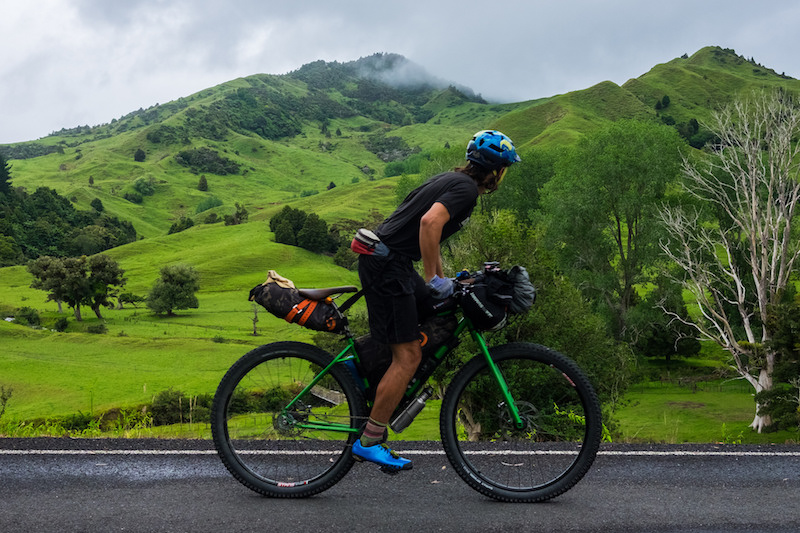
In college, I spent a college semester abroad in Wellington, the capital city. I’d loved it there. I loved the smell of the city — like roasting coffee beans and rain. I loved the kind, quirky people, and their flightless national bird. I loved the clean rivers and easy mountain access. I even loved the ridiculous winds that whip into Wellington from Antarctica, which can turn umbrellas inside-out and fling hats off peoples’ heads. The only thing that was missing was Montana.
After that trip, I was still on the Air New Zealand email list. So when a cheap flight deal popped up in my inbox, we bought the tickets. It was late August. We’d leave in November. Two months seemed like enough time to plan. At the time.
A 12-hour plane ride and we were in Auckland. I had a stomach ache from the in-flight food, and my bike box was apparently still on the tarmac at LAX.
Montana whipped out his laptop and searched for a way to get to our hostel from the airport with only one bike. Our phones didn’t work here. Neither would our credit cards, yet. In our rush to leave the U.S., I hadn’t told our bank that we’d left. I sat down on the ground and felt an overwhelming need to cry — airports do that to me sometimes.
A group of airport employees walked past. One of the women glanced at me, then swooped down beside me.
“Are you okay?” She asked. “Can I buy you a hot chocolate?” In a minute, she pressed a steaming cup of cocoa into my hands and a cappuccino into Montana’s.
“It’ll be okay,” she promised, eyes shining and earnest. “They’ll get it sorted.”
I love these people.

Three days later, the airport got it sorted, and I got my bike. A fellow named Hamish let us crash at his airy beach house outside of Auckland for a couple nights. Hamish had just returned from a 500-mile tour down the California coast — on a long board. When we asked him how that trip was, he shrugged and said, “Ah, yeah. It was good.” Kiwis can be humble to a fault.
We pored over some of Hamish’s maps and books. Something most people do months before a trip. But New Zealand is really far away and hard to conceptualize.
Two options came up. We could follow the Tour Aotearoa (the islands’ Māori name, the “Land of the Long White Cloud”), a gravel-ish brevet route connecting a bunch of bike routes from north to south. Or we could ride Te Araroa, New Zealand’s longest hiking trail.
Te Araroa means “The Long Pathway” in Māori. The TA is a 1864-mile route from New Zealand’s northern tip in Cape Reinga to its southern tail at a place called Bluff. From what we could tell, it was made of some trails, a few paved road connectors and a lot of walking through farmland. Nobody had ever biked it before, and we couldn’t find any laws specifically forbidding bikes on the trail.
I’m more of an ultralight gravel tourist than a serious backcountry bikepacker. But Montana lives for big, epic, uncomfortable rides. Since I did drag him halfway across the planet, I figured we could at least try it.
We told Hamish about our plans to ride Te Araroa.
“Hm,” he said. A long pause while Hamish chewed a piece of grass-fed New Zealand cheese. “Well, you’re quite keen.”
We haul our bikes back up the trail. It’s significantly harder than going down.
At the top, I’m hot again and covered in mud. Montana fiddles with his Garmin to find a way out of the dense, drippy forest.
“No. More. Hiking. Trails.” I huff.
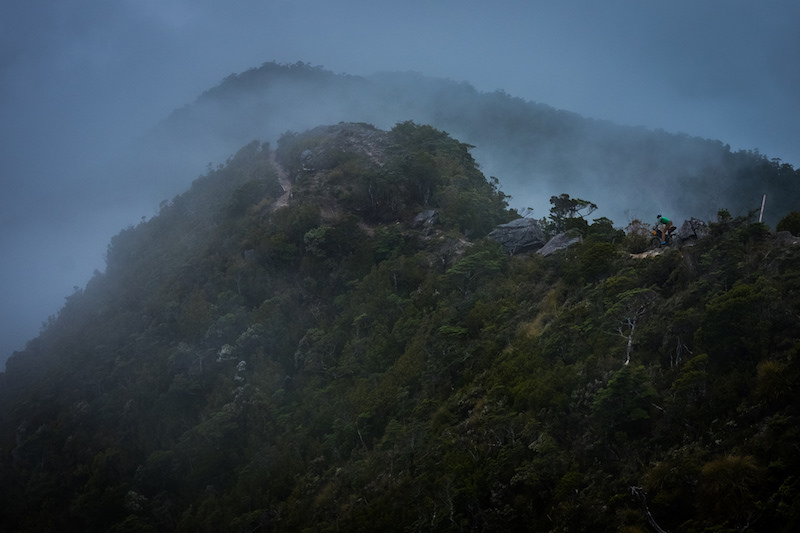
We bail out onto the closest road and find a primitive campsite a few miles away. It’s quiet, with a small stream running nearby. After we’ve unpacked and set up our tent, a few TA through-hikers trickle in. They’re crusted in mud and sunburned after a few days on the trail. They throw their packs down in a heap and lay in the grass. We ask how far they’ve come today.
“Twenty miles today,” one of the women tells us. “But in the forest yesterday we only did six. All day. We were walking in mud up to our knees.”
I give Montana a long stare while I stir our pot of noodles.
We loop back to Auckland the long way, riding some gravel roads, and a lot of pavement. Huge tree ferns and ancient kauri trees line the steep mountain roads. Placid white sheep wander in rolling fields where native people once hunted giant flightless Moa. If I squint, the landscape actually looks a lot like Pennsylvania.
“It’s like we came all the way over here to ride in West Virginia,” he says at camp one night. But I love riding in Appalachia. I’m not disappointed.
Up and over the mountains, we ride along the North Island’s eastern coast to see the beaches and bays. Pōhutukawa trees bloom bright red along the water’s edge. Quaint Victorian houses nestle into the steep grooves of the hillsides, with neat gardens fighting back against the creeping forest. We pitch our tent most nights in big private campgrounds. At the forest’s edge, the wild kiwi birds shuffle and shriek.
It’s scenic riding and comfortable camping. But we’re traveling at the peak of New Zealand’s summer, and tourism is one of the country’s main industries. In a country of just about 4.7 million people, 1.8 million tourists take up a lot of space.
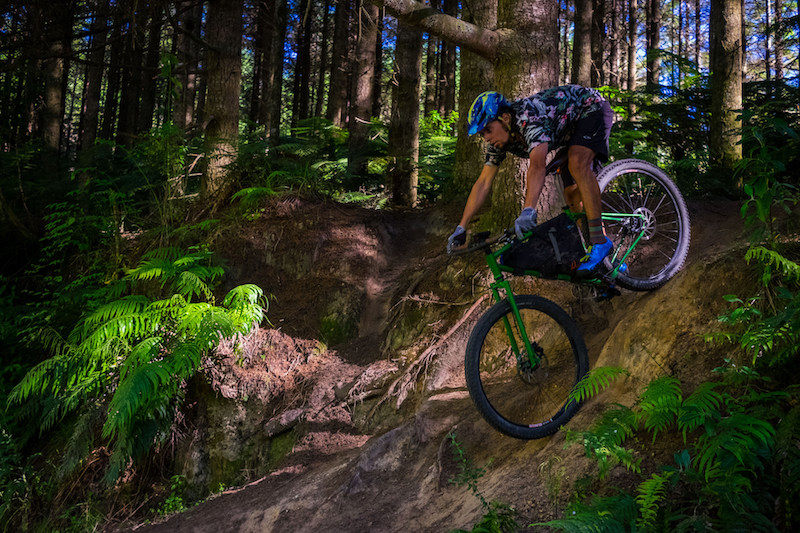
Most roads are narrow, with two lanes and itty bitty shoulders. As we ride along the coast, huge tour buses and overloaded RVs blow past us with inches to spare. The bridges are even narrower. We develop a bridge-sprinting technique so we don’t get squashed by logging trucks. Even the gravel roads aren’t safe from rental-car intrusion. At the top of the most remote climbs, we see silver Toyota sedans creeping along with travelers snapping photos out the car windows. At every scenic overlook, tour buses belch out 70 people with selfie sticks clamoring to find a people-free angle of the mountains.
Almost every campsite we find, no matter how remote, has at least ten other people by the end of the night. We’ve stopped staying in hostels because they’re all overrun with European teenagers swigging shots and playing music all night long. When I was here for school, I didn’t venture out of the city too often. Daily life in the capital city must have sheltered me from the tourist swarms.
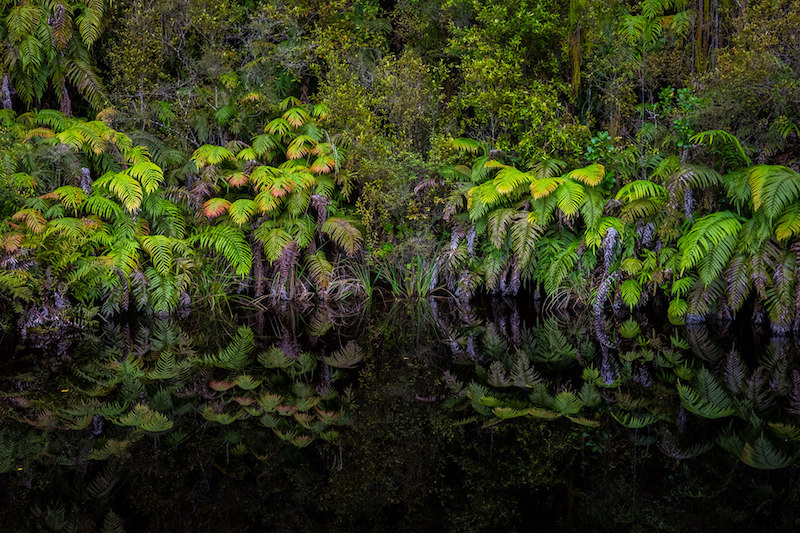
We venture onto hiking trails a few more times, but they end up like the first — jungle too dense to push a bike through, long river walks and swing bridges made of ropes. These trails are no joke. Finally, a Kiwi friend sets us straight.
“Well you can’t take a bike tramping,” she scoffs.
“Wait, so what’s tramping?” Montana asks.
Tramping isn’t hiking, she tells us. Basically, tramping is bushwhacking with a bit of direction. There might be a faint line on a map to follow or some posts stuck in the ground. But there’s usually not a trail — at least not the type we’re used to seeing in the States. Most tramping trails, like the TA, are impossible to ride on a loaded bike.
If we wanted to access the really remote places, we should’ve brought our hiking boots.
As we spin through the suburbs north of Auckland, I spot a prone figure laid out under a tree. I peer into the shade. It’s a through-hiker, resting on his backpack with a hat over his face. His hiking poles are stuck in the dirt. I guess we’re getting to ride part of the trail after all.
We spend two weeks in Rotorua with our friends Nicky and Josh. Rotorua is famous for its geothermal activity, rotten-eggy air, whitewater rafting and its enormous Redwood Forest, laced with over 60 miles of sweet singletrack. They let us crash on their living room floor while we’re waiting for fresh tires to ship from Pennsylvania.
We hit the Redwoods every day. As I swoop through the piney trees, I remember again why I like mountain biking so much.
On Christmas our friends take us rafting down the Kaituna River, emerald water carving through a leafy green gorge. We plop over a 23-foot waterfall, and I’m proud of myself for not puking in the boat.
Nicky and Josh invite us to the raft guide’s Christmas party. I get a raging sunburn watching a kayaker’s rugby match and drink too much wine. The part gets rowdy when the sun sets. Someone makes a trash can fire in the front yard, so I warm up next to it.
A loud, drunk dude turns to me.
“So, what do you think of your new president?” he brays.
“I didn’t vote for him,” I say.
“Ha! What an asshole,” he says. “No wonder your president is an asshole. You Americans are all so dumb.”
I scoot to the other side of the fire. Christmas isn’t the time to talk drunk-politics.
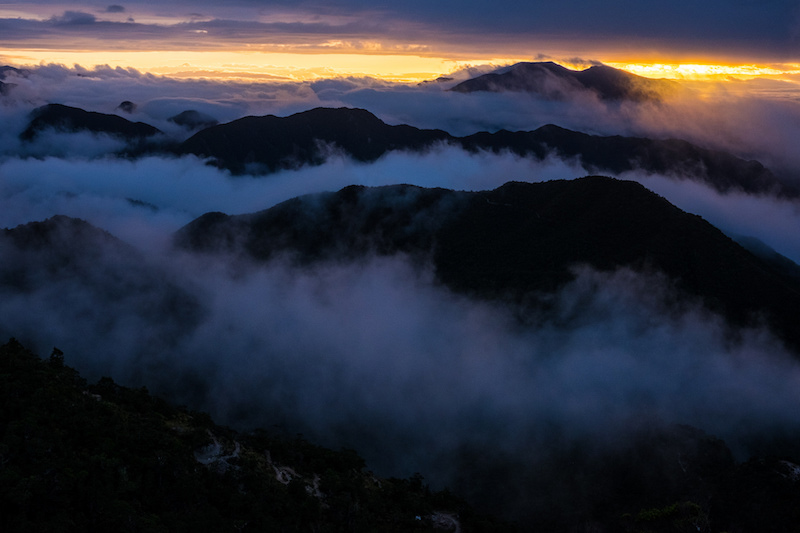
A storm is coming soon. At the trailhead this morning it was sunny and calm. But now blackish clouds are rolling over the mountains. New Zealand is a maritime climate, so weather changes fast. They don’t call it the “Land of the Long White Cloud” for nothing.
We’re finally in the South Island, the more mountainous half of the country. The South Island has tourists as numerous as the sandflies, maddening biting midges that attack in swarms so thick they go up your nose. But right now we’re up high, away from the flies and the people.
The trail we’re riding is the Old Ghost Road. People have been telling us about this ride since we got here. It’s living up to the hype. This ride is incredible — 85 km of singletrack winding from the dense bush, climbing up to the misty mountains and dropping back down into the bush along the Buller River.
The Old Ghost Road is based on an 1886 map of a potential route between the towns of Lyell and Seddonville. During the height of New Zealand’s gold rush, miners were scrambling to explore all the mountains in the south. But the industry caved before the road was finished.

In 2005 some keen Kiwi mountain bikers saw the map and realized there were still traces of a track up there. Volunteers rallied up some money, tools, helicopters, and dynamite and hacked away at the trail till it was finished in 2015.
The whole shebang cost $6.5 million, but the New Zealand government has high expectations for returns on the investment. New Zealand’s West Coast has been depressed by the global dip in coal and dairy prices. There’s nothing they can do about that, but tapping into the national tourism boom with projects like the Old Ghost Road could bring new jobs and money into an otherwise quiet corner of the country.
The trail has four swanky new huts with running water, huge kitchens with gas stoves and wood fires, plus eight separate “summer sleepouts,” unheated sheds with bunks. There are also a few helipads so tour operators can shuttle people, bikes, and gear up to the huts. A guy from Lyell told us about a group of wealthy guys on a mountain bike trip who’d had dinner, whiskey and a dozen tuxedoes choppered to the top of the mountain for a swanky post-ride hut party.
Up on the ridge, I get off my bike to snap a picture of Montana riding the chunky white line across the mountains. A big wind buffets me sideways. Those clouds look nasty.

I coast down to the twisty bit. Loose rocks crumble away down the mountainside. Hop off. Walk. Preserve the self. Gusty rain-smelling wind. Walk faster. Get back on, coast, brake, walk. Singletrack is so awkward on a loaded bike.
Back down in the trees, I pedal fast. There’s a loud mechanical whirrrrr behind me. I get off and step to the side. A guy in an orange vest on a little dirt bike tips his ball cap as he buzzes past. Must be a trail maintenance day.
“Just about there!” he calls out.
Over the next hill is the Ghost Lake Hut, perched on a cliff overlooking a long ribbon of singletrack spooling down into the gorge below. A range of green-blue mountains stretches away into the distance under a wooly smattering of clouds.
The hut’s all booked for the night because a volunteer crew there to improve a few sketchy berms, so we set up camp outside on a platform. A weka, one of the island’s craftier flightless birds, snatches my toiletries pouch in its beak and scurries under a bush.
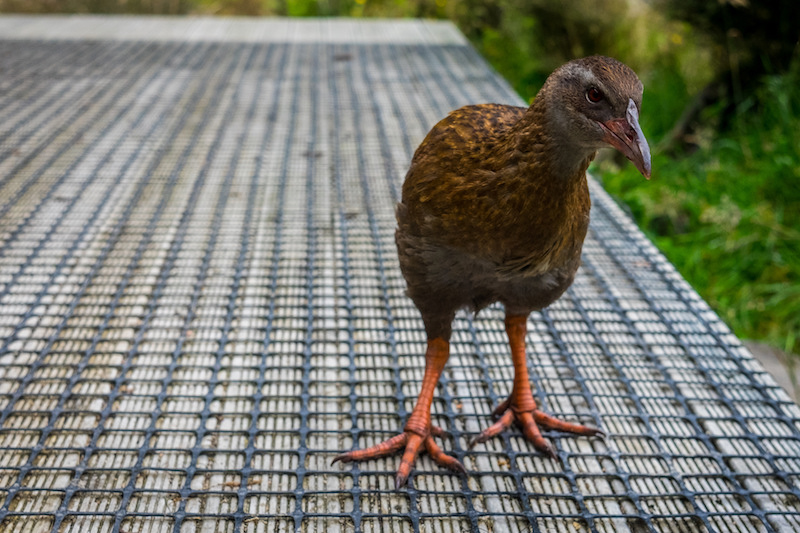
We eat our beans-and-rice dinner as the sun slides behind the mountains, touching the blue clouds with pink and gold for a few moments. We share a bit of leftover wine from a Kleen Kanteen bottle.
This is perfect. This is the New Zealand we came for.
Want to tour Aotearoa?
Time to visit: December – April
Islands to visit: both
Ride these:
- Great Lake Trail
- Rotorua’s Redwoods – Whakarewarewa Forest
- Timber Trail
- West Coast Wilderness Trail
- Old Ghost Road
- Molesworth Muster Trail
- Rainbow Trail
- Alps 2 Ocean Cycle Trail
- Singletrack in Christchurch
Don’t forget: hiking boots, bug spray, high-visibility riding gear

Eat all the: meat pies, local cheese